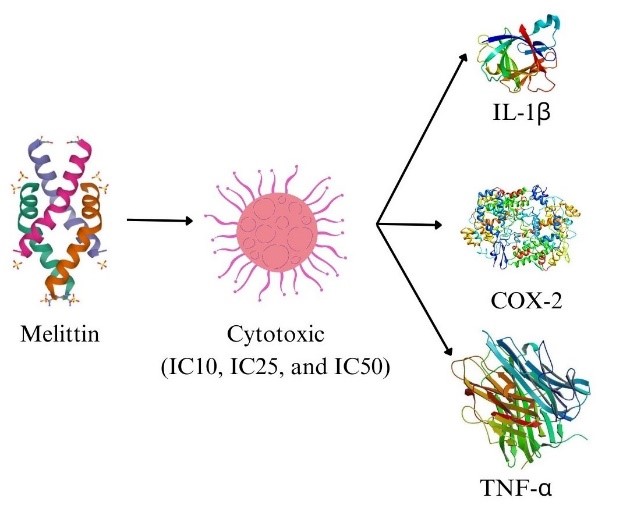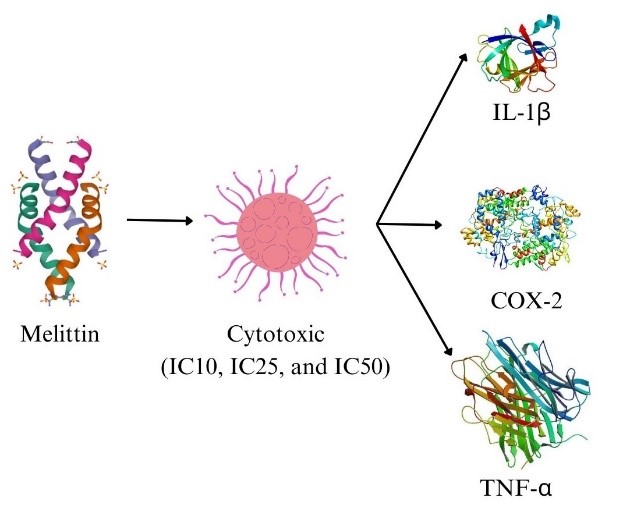Melittin, A Potential Natural Toxin with Anticancer Properties: Regulating IL-1β, COX-2 and TNF-α in Human Colorectal Cancer Cells WiDr
DOI:
https://doi.org/10.48048/tis.2024.7424Keywords:
Antiproliferation, Colorectal cancer, Cytokines, Melittin, ToxicityAbstract
Despite decades of study, the antiproliferation and molecular processes of the biomolecular elements of honeybee venom (i.e., melittin) as anticancer agents remain largely unclear. This study illustrated the antiproliferation effect of melittin by regulating IL-1β, COX-2 and TNF-α in human colorectal cancer cells WiDr. In order to assess the antiproliferation, various concentrations of melittin were contacted to the WiDr cell through MTT assay. Moreover, the ability of melittin to regulate the expression of IL-1β, COX-2 and TNF-α was determined by ELISA. The cytotoxic effect showed the inhibition of the WiDr cell in a dose-dependent manner, with the IC10, IC25 and IC50 values of 0.095 ± 0.001, 0.147 ± 0.002 and 0.207 ± 0.004, respectively. Additionally, in further investigations, melittin markedly inhibited the IL-1β and COX-2 expression but induced the TNF-α, demonstrating significant (p < 0.05) elevations compared to the control group. These findings point to the antiproliferative properties of melittin in WiDr cells. Therefore, as a unique natural treatment for colorectal cancer, melittin may have a lot of potential.
HIGHLIGHTS
- In this study, we confirmed melittin has very strong anticancer activity against colorectal cell cancer cells with IC50 values of 0.207 ± 0.004 µM
- Melittin regulates colorectal cell cancer by inhibiting the IL-1β and COX-2 expression
- Melittin increases the expression of TNF-α to inhibit colorectal cell cancer
GRAPHICAL ABSTRACT

Downloads
Metrics
References
JM Kocarnik, K Compton, FE Dean, W Fu, BL Gaw, JD Harvey, HJ Henrikson, D Lu, A Pennini, R Xu, E Ababneh, M Abbasi-Kangevari, H Abbastabar, SM Abd-Elsalam, A Abdoli, A Abedi, H Abidi, H Abolhassani, IA Adedeji, QES Adnani, ..., LM Force. Cancer incidence, mortality, years of life lost, years lived with disability, and disability-adjusted life years for 29 cancer groups from 2010 to 2019: A systematic analysis for the global burden of disease study 2019. JAMA Oncol. 2022; 8, 420-44.
T Sawicki, M Ruszkowska, A Danielewicz, E Niedźwiedzka, T Arłukowicz and KE Przybyłowicz. A review of colorectal cancer in terms of epidemiology, risk factors, development, symptoms and diagnosis. Cancers 2021; 13, 2025.
J Douaiher, A Ravipati, B Grams, S Chowdhury, O Alatise and C Are. Colorectal cancer-global burden, trends, and geographical variations. J. Surg. Oncol. 2017; 115, 619-30.
J Xie, Y Zhang and L Jiang. Role of interleukin-1 in the pathogenesis of colorectal cancer: A brief look at anakinra therapy. Int. Immunopharm. 2022; 105, 108577.
C Rébé and F Ghiringhelli. Interleukin-1β and cancer. Cancers 2020; 12, 1791.
Y Li, R Cao, T Gu, C Cao, T Chen, Y Guan and X Zhang. PPARβ/δ augments IL-1β-induced COX-2 expression and PGE2 biosynthesis in human mesangial cells via the activation of SIRT1. Metabolites 2022; 12, 595.
W Liu, X Lu, P Shi, G Yang, Z Zhou, W Li, X Mao, D Jiang and C Chen. TNF-α increases breast cancer stem-like cells through up-regulating TAZ expression via the non-canonical NF-κB pathway. Sci. Rep. 2020; 10, 1804.
D Cruceriu, O Baldasici, O Balacescu and I Berindan-Neagoe. The dual role of tumor necrosis factor-alpha (TNF-α) in breast cancer: Molecular insights and therapeutic approaches. Cell. Oncol. 2020; 43, 1-18.
A Ramos, S Sadeghi and H Tabatabaeian. Battling chemoresistance in cancer: Root causes and strategies to uproot them. Int. J. Mol. Sci. 2021; 22, 9451.
C Duffy, A Sorolla, E Wang, E Golden, E Woodward, K Davern, D Ho, E Johnstone, K Pfleger, A Redfern, KS Iyer, B Baer and P Blancafort. Honeybee venom and melittin suppress growth factor receptor activation in HER2-enriched and triple-negative breast cancer. npj Precis. Oncol. 2020; 4, 24.
M Plasay, R Natzir, MH Cangara, M Hardjo, Syahrijuita and GV Soraya. Melittin-induced cell death through p53 and 8-OHdG in breast cell cancer MCF-7. Biomed. Pharmacol. J. 2022; 15, 979-83.
NT Hamdan, BAAAA Jwad and SA Jasim. Synergistic anticancer effects of phycocyanin and Citrullus colocynthis extract against WiDr, HCT-15 and HCT-116 colon cancer cell lines. Gene Rep. 2021; 22, 100972.
M Tanumihardja, S Hastuti, JJ Nugroho, AC Trilaksana, N Natsir, CA Rovani and L Muslimin. Viabilities of odontoblast cells following addition of haruan fish in calcium hydroxide. Open Access Macedonian J. Med. Sci. 2020; 8, 58-63.
A Wang, Y Zheng, W Zhu, L Yang, Y Yang and J Peng. Melittin-based nano-delivery systems for cancer therapy. Biomolecules 2022; 12, 118.
P Askari, MH Namaei, K Ghazvini and M Hosseini. In vitro and in vivo toxicity and antibacterial efficacy of melittin against clinical extensively drug-resistant bacteria. BMC Pharmacol. Toxicol. 2021; 22, 42.
HR El-Seedi, N Eid, AAA El-Wahed, ME Rateb, HS Afifi, AF Algethami, C Zhao, YA Naggar, SM Alsharif, HE Tahir, B Xu, K Wang and SAM Khalifa. Honey bee products: Preclinical and clinical studies of their anti-inflammatory and immunomodulatory properties. Front. Nutr. 2022; 8, 761267.
JE Lee, VK Shah, EJ Lee, MS Oh and JJ Choi. Melittin - A bee venom component - Enhances muscle regeneration factors expression in a mouse model of skeletal muscle contusion. J. Pharmacol. Sci. 2019; 140, 26-32.
J Chen, SM Guan, W Sun and H Fu. Melittin, the major pain-producing substance of bee venom. Neurosci. Bull. 2016; 32, 265-72.
JP Feng, R Zhu, F Jiang, J Xie, C Gao, M Li, H Jin and D Fu. Melittin-encapsulating peptide hydrogels for enhanced delivery of impermeable anticancer peptides. Biomater. Sci. 2020; 8, 4559-69.
IW Hamley. Small bioactive peptides for biomaterials design and therapeutics. Chem. Rev. 2017; 117, 14015-41.
GH Mansour, MA El-Magd, DH Mahfouz, IA Abdelhamid, MF Mohamed, NS Ibrahim, AHAA Wahab and EM Elzayat. Bee venom and its active component melittin synergistically potentiate the anticancer effect of sorafenib against HepG2 cells. Bioorg. Chem. 2021; 116, 105329.
O Dmitrieva-Posocco, A Dzutsev, DF Posocco, V Hou, W Yuan, V Thovarai, IA Mufazalov, M Gunzer, IP Shilovskiy, MR Khaitov, G Trinchieri, A Waisman and SI Grivennikov. Cell-type-specific responses to interleukin-1 control microbial invasion and tumor-elicited inflammation in colorectal cancer. Immunity 2019; 50, 166-80.
F Martín-Sánchez, JJ Martínez-García, M Muñoz-García, M Martínez-Villanueva, JA Noguera-Velasco, D Andreu, L Rivas and P Pelegrín. Lytic cell death induced by melittin bypasses pyroptosis but induces NLRP3 inflammasome activation and IL-1β release. Cell Death Dis. 2017; 8, e2984.
L Wang, LF Zhang, J Wu, SJ Xu, YY Xu, D Li, JT Lou and MF Liu. IL-1β-mediated repression of microRNA-101 is crucial for inflammation-promoted lung tumorigenesis. Canc. Res. 2014; 74, 4720-30.
X Wang and Y Lin. Tumor necrosis factor and cancer, buddies or foes? Acta Pharmacol. Sin. 2008; 29, 1275-88.
AJ Freeman, CJ Kearney, J Silke and J Oliaro. Unleashing TNF cytotoxicity to enhance cancer immunotherapy. Trends Immunol. 2021; 42, 1128-42.

Downloads
Published
How to Cite
Issue
Section
License
Copyright (c) 2023 Walailak University

This work is licensed under a Creative Commons Attribution-NonCommercial-NoDerivatives 4.0 International License.






